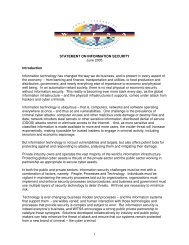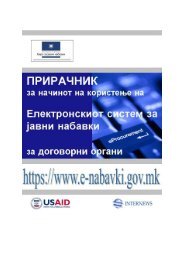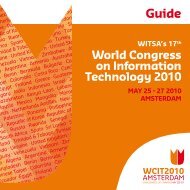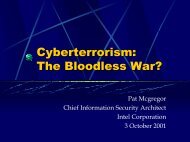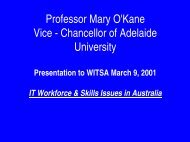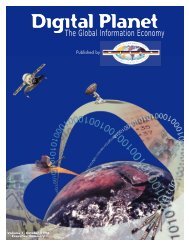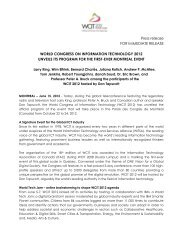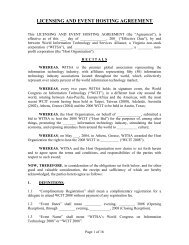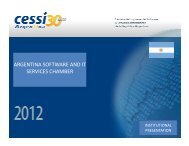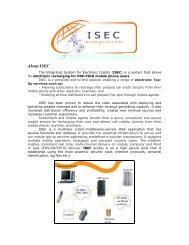Services over Internet Protocol: Voice is just the beginning… - WITSA
Services over Internet Protocol: Voice is just the beginning… - WITSA
Services over Internet Protocol: Voice is just the beginning… - WITSA
- No tags were found...
You also want an ePaper? Increase the reach of your titles
YUMPU automatically turns print PDFs into web optimized ePapers that Google loves.
Top Ten Technology Trends1. IP Will Eat Everything!2. Broadband Will Be Common3. Wireless <strong>Internet</strong> Will Be Big – Driving Mobility4. Sensor Networks Will Be Everywhere5. Convergence of Communications &Computers Will Become a Reality6. Death of Locality7. Security Is Critical8. NexGen D<strong>is</strong>tributed Computing Is Growing9. Home LANs Will Proliferate10. Data Mining Information Mining3Copyright 2004 AT&T
IP Will Eat Everything
From:The Communications Industry <strong>is</strong> Undergoing MassiveTransformationto One MPLS/IP NetworkLegacy NetworksTo:Common IP/MPLS Backbone<strong>Voice</strong>NetworkFrame/ATM4ESS5ESS5ESSFrame/ATM/<strong>Voice</strong>/IP-VPNThe <strong>Internet</strong>BX9000BX9000BX9000Private LineNetworkMSERoute ServersRoute ServersGlobal IPNetworkMSEMPLS CoreFrame/ATM/<strong>Voice</strong>/IP-VPNIP BackboneMPLS: Multi<strong>Protocol</strong> Label Switching5Copyright 2004 AT&T
IP <strong>is</strong> <strong>the</strong> <strong>the</strong> Bridge to <strong>the</strong> FutureTeleworkerWireless<strong>Internet</strong>PrivateNetworks(WAN/VPN)•Secure•High Performance•Predictable•Reliable•Non-RegulatedCorporateIntranetSupplierCorporateExtranetPublic <strong>Voice</strong>Networks(PSTN)•Scalable•Ubiquitous•VariablePerformance•Seamless•Flexible•RegulatedLANSupplierTeleworkerSupplierISPCustomer6Copyright 2004 AT&T
IP Enables <strong>the</strong> Next Generation of ApplicationsCOMMUNICATION LAYERSContent Layer(movies, books, papers,information, etc.)Application Layer(voice, video, web, chat,e-mail, etc.)Logical Layer(IP addressing, wirelesshandoffs, etc.Physical Layer(electric, co-axial, copper,wireless, fiber)Open standard datanetworks, such as IP,operate in layers thatallow applications to beseparated from <strong>the</strong>infrastructure– Enables multipleplayers to enter <strong>the</strong>market at differentlayers and compete,stimulating innovation– The type of <strong>the</strong> network(electric, co-axial,copper, wireless, fiber)no longer dictates <strong>the</strong>application or servicesConcept compliments of Kevin Werbach7Copyright 2004 AT&T
IP PhoneTelephoneIP Makes <strong>the</strong> V<strong>is</strong>ion of Any Device to Any Device<strong>over</strong> Any Network PossibleDSLModemVoIPRouterCableModem<strong>Internet</strong>/IPNetworks(178,000+ networks)3GCellphoneLaptopLANConnectionVoIPGatewayPhoneLineCordlessPhoneWifiPDADSLLineISPGatewayPBXGatewayCable ModemWiFi Access PointDesktopTelephonePhoneLineiPBX(Gateway)IP SoftphoneVoIPCustom DialerPBXTelephoneIP Phone8Copyright 2004 AT&T
VoIP
VoIP Technology Will Challenge Traditional Assumptionsand Traditional Regulatory Models• “VoIP” <strong>is</strong> more than “<strong>Voice</strong>”– The <strong>Voice</strong>/ Data dichotomy <strong>is</strong> eroding rapidly– VoIP <strong>is</strong> not simple voice, but ra<strong>the</strong>r a converged multimediaapplication that supports voice, data and video• Innovation and investment by fixed and wireless operators in IPnetworks will have an economic impact• IP communications have <strong>the</strong> potential to d<strong>is</strong>rupt <strong>the</strong> status quoin service provider environment, elevating applications• Revolutionary opportunity for consumers; evolutionary forbusinesses• VoIP development and regulation should follow a cellular modelra<strong>the</strong>r than a traditional fixed voice model – services willimprove <strong>over</strong> time, not <strong>over</strong>night, to meet customer demand10Copyright 2004 AT&T
The Eras of VoIPEmergingApplicationsConvergence& ConsolidationArbitrage11Copyright 2004 AT&T
IP Enabled <strong>Voice</strong> <strong>Services</strong> – The Early DaysNCPNCPPSTNLocalLocal NetworkLECADJEdge-to-Edge CircuitEdge SwitchEdge SwitchUpchainADJ4ESS4ESSReal Time Network RoutingPBXInt’lCarrierNGBENGBECCEIP/<strong>Internet</strong> CoreNGBEPNBEInt’lCarrierLocal CLEC/ILECCustomer Router/Gateway12Advanced <strong>Voice</strong> Features Across TDMVoIP transport with hop-on/hop-offCopyright 2004 AT&TPBXDefinitions• BE – Border Element• CCE – Call Control Element• ING – Integrated Network Gateway• NCP – Network Control Point• NGBE – Network Gateway BorderElement• PNBE – Peer Network BorderElement
IP Enabled <strong>Voice</strong> <strong>Services</strong> – Today’s Build-outLECLEC - TDMWholesaleCustomerIP PBXEVPNCarrierES-INGIP-Enabled Edge ℡SIPCPENGBEPNBEIP ResidenceDSLCableEtc.LocalBE App SrvrCCEIP/MPLS/<strong>Internet</strong> CoreLocal INGAppSrvr AppSrvrIP - ApplicationsMediaSrvrIP-Enabled Local NetworkSIPPNBENGBEES-INGInt’lCarrierIP-Enabled EdgePBX - TDMLECInterconnect local, toll & international switches with IP.Replace Adjuncts with Media Servers to reduce capex.Interconnect private VPNs with public VoIP services.13Copyright 2004 AT&TDefinitions•BE – Border Element•CCE – Call Control Element•ING – Integrated Network Gateway•NGBE – Network Gateway Border Element•PNBE – Peer Network Border Element•BS - Business
IP Changes Investment – New Investment Essential toEnable Real time IP ApplicationsBillions ofDollars ofEquipmentExpenditure$70$60$50$40$30$20$10$02002Data/Communication NetworksWorldwide Equipment Investment Estimate2003(E)2004(E)2005(E)2006(E)2007(E)CORE Carrier andEnterpr<strong>is</strong>e Backbones(DWDM, Routers,Switches - optical, WAN,& converged)ACCESS (CPE,Concentrators, DWDMMetro, Firewall, VPN,Wireless LAN, E<strong>the</strong>rnetSwitches)END POINT Enterpr<strong>is</strong>eCPE (IP PBXs & phones)Source: Based on data from Prudential SecuritiesNote: Software, network integration, consulting and product support expenditures areexpected to match and eventually surpass total equipment expenditures per year.14Copyright 2004 AT&T
TraditionalTelecom<strong>Services</strong><strong>Voice</strong> Becomes Ano<strong>the</strong>r Data ApplicationOn an IP Network IP/<strong>Internet</strong> Applications<strong>Internet</strong> <strong>Protocol</strong> (IP) separatesapplications from <strong>the</strong> network:– <strong>Voice</strong> <strong>is</strong> not longerrestricted to telephonenetworks– <strong>Voice</strong> becomes ano<strong>the</strong>r IPdata applicationCircuit Switched <strong>Voice</strong>Enhanced/Information<strong>Services</strong>Public Phone Network<strong>Voice</strong>VideoSIP.. H.323..IPDomainName ServiceE-mailSatellite, Wireless, Cable,Phone, Electric NetworksWWWSMTPPOP3.. DNS.. HTTPTCP…UDP...RTP…(<strong>Internet</strong><strong>Protocol</strong>)Packet Routed DataPhysical Layer Logical LayerApplication Layer15Copyright 2004 AT&T
MediaNew Models of G<strong>over</strong>nance NeededCurrent NormTelecomDEVICESCONTENTAPPLICATIONSNETWORKSComputing“Stovepipe” regulation byindustry and sectorsbut INTERNETPROTOCOLchanges everything• Vertical convergence• Horizontal convergenceNew Questions:• Jur<strong>is</strong>diction• Accountability• Liability• Industry/Gov’tCooperation16Copyright 2004 AT&T
Definitions• <strong>Internet</strong> Telephony: “In <strong>the</strong> beginning, <strong>Internet</strong> telephony simplymeant <strong>the</strong> technology and techniques to let you make voice phone calls –local, long d<strong>is</strong>tance, and international – <strong>over</strong> <strong>the</strong> <strong>Internet</strong> using yourPC…<strong>the</strong> definition of <strong>Internet</strong> telephony <strong>is</strong> broadening day by day toinclude all forms of media (voice, video, image), and all forms ofmessaging and all variations of speed from real-time to time-delayed.”• IP Telephony: (As defined by Microsoft) “IP Telephony <strong>is</strong> an emergingset of technologies that enables voice, data, and video collaboration <strong>over</strong>ex<strong>is</strong>ting IP-based LANs, WANs and <strong>the</strong> <strong>Internet</strong>. Specifically, IP Telephonyuses open IETF and ITU standards to move multimedia traffic <strong>over</strong> anynetwork that uses IP (<strong>the</strong> <strong>Internet</strong> <strong>Protocol</strong>).”• <strong>Voice</strong> <strong>over</strong> IP (VoIP): “The technology used to transmit voiceconversations <strong>over</strong> a data network using <strong>the</strong> <strong>Internet</strong> <strong>Protocol</strong>. Such datanetwork may be <strong>the</strong> <strong>Internet</strong> or a corporate Intranet, or managednetworks typically used by long and local service traditional providers andISPs that use VoIP.”Source: Newton’s Telecom Dictionary, 18 th edition17Copyright 2004 AT&T
VoIP:An information service that delivers voicecommunications and enables voice convergence witho<strong>the</strong>r data applications and devices.WHAT THE FUTURE HOLDS:• Presence (Instant Messenger, Follow me)• One Number / “Follow Me” <strong>Services</strong>• IP Call Centers• Universal Messaging• Virtual Meetings / Collaboration (likeNetMeeting)• Real time language translation• IP Centrex• Multi-Point Videoconferencing• Desktop Multimedia• Push to Talk Cellular• <strong>Voice</strong> Chat18Copyright 2004 AT&T
The Evolution of Residential VoIPComputerTelephoneBroadbandWWW2004VoIPGatewayDSL or CableModemPSTNComputerDSL or CableModemBroadbandWWWTelephonePhoneLinePSTNTelephoneWWWComputer14.4 – 56k ModemPhoneLinePSTNTelephonePhoneLinePSTN 199219Copyright AT&T 2004 AT&T 2003
Snapshot: U.S. Domestic VOIP Market Just BeginningSubs (M)10.08.06.04.0U.S. POTS Lines ~ 100MDomstic IP AdoptionGoldman SachsIn-Stat/MDRMorgan Stanley2004 2004 Snapshot Snapshot 2 nd line penetration <strong>is</strong> 18%Only 25M homes have a highspeed internet connection40 M households don’t have aPC2.00.02003 2004 2005 2006 2007 2008Domestic IP Telephony Subscribers (in millions)2003 2004 2005 2006 2007 2008Goldman Sachs 0.1 0.9 2.2 3.8 5.7 7.7Morgan Stanley 0.1 0.8 1.4 1.9 2.1 2.5In-Stat/MDR * 1.3 1.7 2.2 3.2 5.2 7.2* includes PC-to-PhoneTraditional phone service has168 M lines; wireless 170 Mnumbers# of Domestic VOIP players stillemergingCable: Cablev<strong>is</strong>ion, Cox, Time WarnerISP: Earthlink, Yahoo BBLEC/IXC: Qwest, AT&TVirtual: Vonage, <strong>Voice</strong>glo, <strong>Voice</strong>pulse,!connec<strong>the</strong>re, Packet8PC: Net2Phone, Free World Dialup20Copyright 2004 AT&T
Emerging VoIP Revenues (hardware and services)are also Dwarfed by Global <strong>Voice</strong> Revenues• Global voice telecom revenues and network usage continue to grow driven by technology options• Communications <strong>is</strong> cumulative• Applications are shifting from wireline voice to a mix of voice, mobile, e-mail, chat and instant messagingREVENUE (Billions of Dollars)1200110010009008007006005004003002001000<strong>Voice</strong> Telecom <strong>Services</strong> were $856Billion in 2000; expected to reach $1.4Trillion by 2005 – compared to less than$7 Billion for VoIP revenues by 20052000 2001 2002 2003 2004 2005 2006REVENUE (Billions of Dollars65432102002 2003 2004 2005 200621VoIP Technology (Equipment)VoIP Service Provider (ISP)VoIP Wholesale (Network)Worldwide <strong>Voice</strong> Telecom Svcs.Copyright 2004 AT&TVoIP Technology (Equipment)VoIP Wholesale (Network)VoIP Service Provider (ISP)Sources: RADICATI Group, Inc., <strong>Voice</strong> Over IP Market Trends 2002-2006, IDC, Worldwide Telecommunications <strong>Services</strong> Revenue Forecastand Analys<strong>is</strong>, 2000-2005
VoIP’s Challenges: Operational,Standards, Policy/Regulatory
Who Should Set Policy for Global IP Networks and VoIP?• FCC?• FTC?•Congress?•StateLeg<strong>is</strong>latures?•NationalParliaments/G<strong>over</strong>nments/Courts?•European Union?• ITU?• WTO?• WIPO?• IETF?• ETSI?•APEC?•NationalParliaments?•NationalParliaments?23Copyright 2004 AT&T
International VoIP Policy Activity• ITU Survey on Implementation of IPTelephony in Developing Countries:Countries vary in <strong>the</strong>ir treatment reregulation:– Include VoIP/all forms in regulatorysystem– Prohibit implementation -Not planning to regulate– Some have not yet addresses <strong>the</strong>se<strong>is</strong>sues– 35 respondents to ITU survey: OnlySpain, Sudan, Singapore, Lituania,Denmark said : should not beregulated.• OECD Report:• More Recent Proceedings Considering VoIP/ VoB Regulatory Framework– US, UK, EC, Canada, Germany• Anticipated Proceedings:– Hong Kong, India, Australia,Singapore, Sweden• Issues Ar<strong>is</strong>ing in Proceedings andD<strong>is</strong>cussions with Policy Makers– Different <strong>is</strong>sues emphasized outsideUS– US focusing on “regulatoryframework” primarily as it impactslegacy inter-carrier compensation andUSO considerations– Outside US, focus on “regulatoryframework” in light of specific rightsand obligations that impact customerdemand, economic development, andpublic safety (e.g numberingresources, entry barriers, lawenforcement ass<strong>is</strong>tance)• Multilateral Interests : ITU and OECD24Copyright 2004 AT&T
International VoIP: Where it’s Growing• Japan• Korea• China• Philippines• India• Hong Kong• Poland• Russia• Bulgaria• Ukraine• Turkey• Senegal• Nigeria• Kenya• Mexico• Colombia• Brazil• Peru25Copyright 2004 AT&T
VoIP’s General Challenges:Much Work to do to Compete with PSTN and DevelopRight Regulatory EnvironmentOPERATIONAL• Physical and logical interconnection• Infrastructure availability• Infrastructure affordability• Quality of service• Security• Billing• Customer care• Fulfillment and device support• Coex<strong>is</strong>tence with legacy equipmentand networks increasing architecturalcomplexityPOLICY• Regulatory classification• Licensing restrictions• Number Resource Allocation• Interconnection Charges• Law Enforcement Ass<strong>is</strong>tance• Access to Emergency <strong>Services</strong>• Emergency Service• QoS/Power Supply• Tariff/Price Controls• Universal Service26Copyright 2004 AT&T
What <strong>WITSA</strong> Might Do to Ensure VoIP’s Success• Backgrounder Paper helps to frame VoIP’s story• Education and Briefings essential for policy makers across rangeof g<strong>over</strong>nmental agencies, NOT <strong>just</strong> regulatory agencies• Be aware that leg<strong>is</strong>lation <strong>is</strong> underway in many countries andmay limit who and how VoIP can be provided; work with o<strong>the</strong>rsto influence leg<strong>is</strong>lation.• Sometimes telecom leg<strong>is</strong>lation included VoIP; be aware thatincumbents often seek to prevent anyone else from providingVoIP• Business Associations and allies, such as ISP Associations,o<strong>the</strong>rs could join toge<strong>the</strong>r to “tell VoIP’s story”, of economicinvestment, productivity, new consumer services, etc.• A “picture” <strong>is</strong> worth a thousand words approach: work wi<strong>the</strong>quipment providers, or VoIP <strong>Services</strong> providers to show <strong>the</strong>technology and tell <strong>the</strong> policy story at <strong>the</strong> same time27Copyright 2004 AT&T
Questions and D<strong>is</strong>cussionMarilyn Cademcade@att.com202-360-1196



![witsa-[association member] ict excellence awards program](https://img.yumpu.com/51340170/1/190x245/witsa-association-member-ict-excellence-awards-program.jpg?quality=85)
